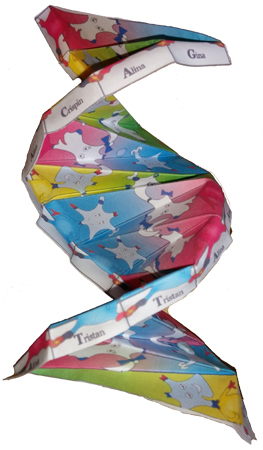Our genome has collected over 3 billion base pairs, separated them into 23 parts and packed them as tightly as they can go. Now what? Unlike many collections which just sit there looking pretty, this one has a myriad of uses. Each of the 23 chromosomes are split further. Some of these regions are called genes (pronounced like the jeans you wear) and there are around 22,000 of them. The majority of the genome is not in a gene. It was rudely dismissed as evolutionary rubbish (junk DNA) until quite recently. We now know that it is involved in regulation and control of the genes.
The genome within the region of a gene is often (but not always!) involved in creating a protein. Proteins are the active ingredients in our body. They produce fibres like collagen (scaffolding to hold things up) and keratin (hair and nails). They produce pigments like melanin (hair, skin and eye colour). They make up the enzymes to digest our food, the muscles to build up our bodies and the histones to roll up our DNA. Proteins are also involved in regulating activity within our cells. Without them we couldn’t exist.
 Dinky Amigos line up in the entire genome in a specific order. Genes are further divided into introns and exons. Proteins are made by translating the exon line up into their own chemical code. This is done by recognising sets of three Dinky Amigos. Each set of three is known as a codon. This codon translates into an amino acid. Amino acids then join together and fold to create the desired protein.
Dinky Amigos line up in the entire genome in a specific order. Genes are further divided into introns and exons. Proteins are made by translating the exon line up into their own chemical code. This is done by recognising sets of three Dinky Amigos. Each set of three is known as a codon. This codon translates into an amino acid. Amino acids then join together and fold to create the desired protein.
Each time a protein is required, the specific gene is made available from the tightly packed genome. The nucleus bustles with packing, unpacking and repacking to keep each cell provided with the requisite proteins.

As with life, not everything that is taken out gets put back exactly. If this happens at a crucial stage in cell development, changes creep in. Some of these changes are significant enough to alter a protein. This often leads to disease. It doesn’t have to though. Changes can also be advantageous. Changes may be carried forward, and joined by new changes. Eventually, over millions of years, a new species may result. Think of your Genome collection as active and dynamic and if you are tempted to blame it for anything, think about all the things it does do for you and how you wouldn’t be you without it.

